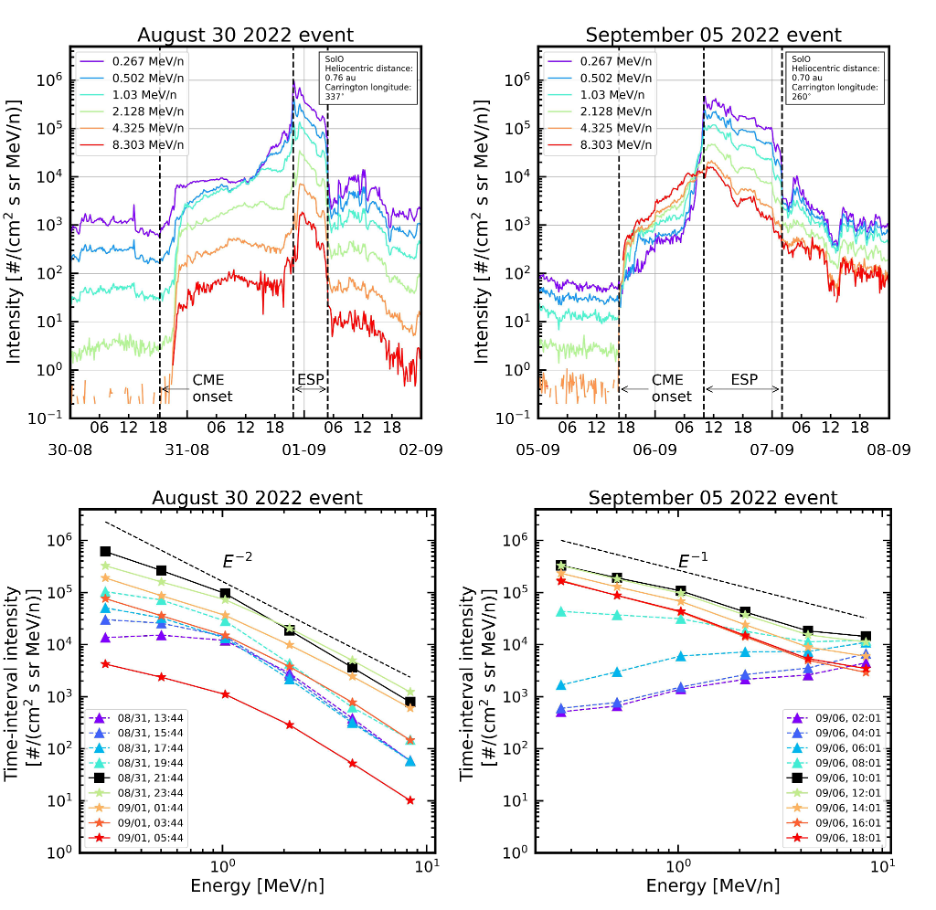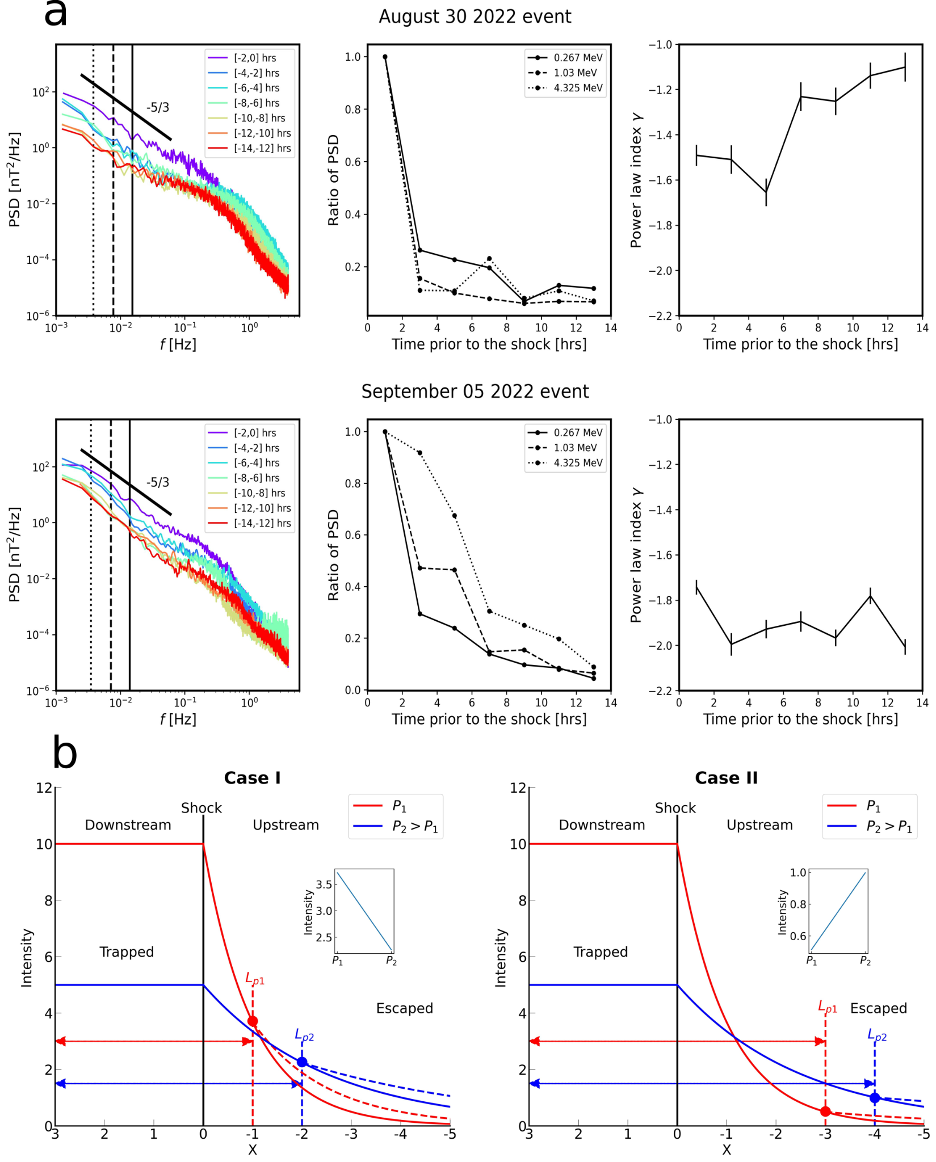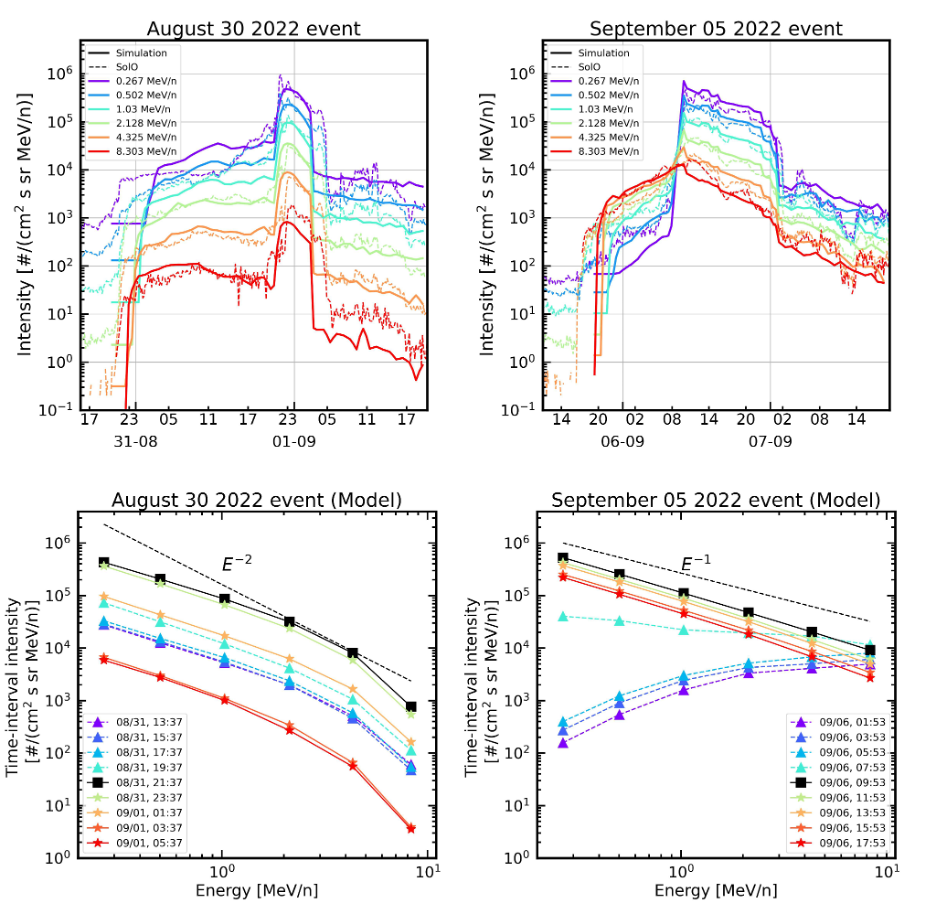Science nugget: Modelling Two Consecutive Energetic Storm Particle Events observed by Solar Orbiter - Solar Orbiter
Modelling Two Consecutive Energetic Storm Particle Events observed by Solar Orbiter
(Solar Orbiter Nugget #25 by Zheyi Ding1, Gang Li2, Glenn Mason3, Stefaan Poedts1,4, Athanasios Kouloumvakos3, George Ho3, Nicolas Wijsen5,6, Robert F. Wimmer-Schweingruber7, Javier Rodríguez-Pacheco8)
Introduction
Energetic Storm Particle (ESP) events are a type of solar energetic particle (SEP) events characterized by the rapid increase in the SEP intensity associated with a shock driven by a coronal mass ejection (CME). Two ESP events, both emanating from the same active region, were observed by the Solar Orbiter on August 31, 2022, and September 5, 2022. Despite their common origin, these events exhibited markedly distinct characteristics in terms of ESP duration, time intensity profiles, and spectral slope. This divergence provides a unique opportunity to advance our understanding of particle acceleration and escape mechanisms associated with CME-driven shocks. This study leverages a combination of observational data from the Energetic Particle Detector (EPD [1,2]) on Solar Orbiter and advanced models (EUHFORIA[3] and iPATH [4,5,6]) to dissect these intriguing SEP phenomena.
Observation
Fig. 1 presents the proton time intensity profiles and 2-hour time-interval proton spectra observed by SolO/EPD for the August 30 and the September 5 events. The key observations from the study include: 1) Diverse Event Durations: The two ESP events differed significantly in duration - the August event lasted approximately 7 hours, while the September event extended over 16 hours. These durations are linked to the passage of shock-sheath structures associated with each event. 2) Unique 'Crossover' Feature: A rare 'crossover' phenomenon was observed in the September event, where low-energy protons near the shock had lower intensities than high-energy protons. This contrasts with typical SEP events. 3) Distinct Proton Spectra: Analysis of the proton spectra revealed that the August event displayed a typical negative power-law, while the September event showed a positive power-law-like behavior upstream of the shock, transitioning to a typical negative power-law across the shock. This difference poses challenges to conventional explanations based solely on particle transport effects.

Figure 1: Upper: Proton time intensity profiles for the August 30, 2022 (left) and the September 5, 2022 (right) events as observed by SolO/SIS. Bottom: Two-hour time-interval proton spectra. The time stamps represent the start of the intervals, ranging from 8 hours before to 8 hours after the arrival of the shock. The black curve with squares corresponds to the time of shock arrival.
Analysis & Interpretation
As demonstrated in Fig. 2(a), the power spectral density (PSD) of the total magnetic field was computed to discern the resonant behavior with different particle energies upstream of the shock, revealing distinct differences between the two events. For the August event, the PSD decayed rapidly within about two hours, whereas for the September event, it showed a slower decay rate, taking approximately six hours. This suggests notable differences in the turbulence dynamics of the events. Further analysis of the spectral slopes, derived from power-law fitting of the spectra, indicated that the September event had a steeper spectral slope, signaling stronger and more developed turbulence ahead of the shock.
From this PSD analysis, we explain how accelerated particles are distributed at the shock and their escape mechanisms as illustrated in Fig. 2(b). Particles within certain distances upstream the shock are trapped by self-excited waves, while those beyond can escape into the ambient solar wind. The different escape lengths observed in the two events, influenced by the decay rate of turbulence strength, played a significant role in the spatial distribution of particles. In scenarios where the escape boundary extends further, the spectral index of the escaped particle intensity can turn positive, leading to a crossover phenomenon. This combined effect of trapping and escape, controlled by different escape boundaries, explains the distinct particle distributions observed in the two events.

Figure 2: (a) Total magnetic field Power Spectral Density (PSD) for August 30, 2022 (upper) and September 05, 2022 (lower) events. The left panels represent the 2-hour interval of PSD as a function of frequency upstream of the shock. 0 represents the time of shock. The dashed vertical lines indicate the corresponding resonant frequencies of different energies by Taylor’s hypothesis. The three energies are labelled in the middle panel. The middle panels show the ratio of PSD as a function of time upstream of the shock, compared to the PSD closest to the shock. The right panels show the fitted power law indices in the frequency range [0.003,0.06] Hz as a function of time. (b) Two schematics of the distribution of accelerated particles at an interplanetary shock for two momenta, adapted from [7]. Both schematics illustrate the momentum-dependent scale length of the exponential decay upstream of the shock and the corresponding trapping and escape of particles. The only difference between the schematics is the different escape length scales LP1 and LP2. The subpanel shows the intensity of the escaped particles for P1 and P2.
Model
We first modeled the solar wind and CME propagation using EUHFORIA [3]. Movie 1 shows the radial speed of the solar wind in EUHFORIA and the following shell structure. The shell structures in the iPATH model are constructed via the realistic 3D shock fronts and time-dependent downstream flow speed from EUHFORIA, thereby capturing the spatial extension of the downstream region of the shock. The radial width of the shell structure for the August event is much narrower than that of the September event, a difference attributed to the distinct deceleration histories of the plasma downstream of the shock. There is strong deceleration of CME for the September event, causing the shell structure to be stretched more by the rapid deceleration of the downstream flow. The radial width of the shell structure is essential for understanding the duration of the ESP event. The arrival of the shock front (the first shell) at the observer marks the onset of the ESP event, while the passage of the last shell marks its end. This demonstrates that the shell module of the iPATH model can serve as a powerful tool to study ESP events.
The iPATH results displayed in Fig. 3, time profiles and spectra at SolO, successfully reproduced key aspects of both events, including the crossover of time profiles in the September event and the duration of the ESP phases. A key factor in the simulation was the choice of the escape length scale and its energy dependence, which differed significantly between the two events. For the August event, a weak energy dependence and short escape length scale were used, resulting in a reasonable match with the observed data. For the September event, a stronger energy dependence and a longer escape length scale had to be invoked to explain the observed crossover in time profiles and the positive spectral index. This indicates the importance of accurately estimating the escape length scale for different SEP events.

Figure 3: Upper: Time intensity profiles from the SolO observation (dashed lines) and the model calculation (solid lines). Bottom: Two-hour time interval proton spectra from the model calculation (same formats as Fig. 1).
Conclusion
In this study we examined two consecutive but very different ESP events observed by the Solar Orbiter, we effectively modelled these two events in terms of their intensity profiles, spectral slopes and ESP duration using combined EUHFORIA and iPATH models. The unusual crossover of time profiles and positive spectral indices in the September event are attributed to the long duration of enhanced turbulence upstream of the shock, which effectively hinders the escape of lower-energy particles from the shock. Our simulation shows that this duration is a consequence of the deceleration history of the CME and the shock it drives. Examination of these two events underscore the need for comprehensive simulations that incorporate realistic solar wind, CME dynamics, and turbulence near the shock to fully grasp the nature of SEP events.
Movie 1: Equatorial (left) and meridional (right) snapshots of the radial solar wind speed from EUHFORIA for the August 30 (upper) and the September 05 (lower) events. The blue curves show the shell structure behind the shock in the equatorial and meridional planes.
This study has been published in Ding et al., 2023, A&A, https://doi.org/10.1051/0004-6361/202347506
Acknowledgements
This work is supported in part by NASA grants 80NSSC19K0075, 80NSSC22K0268, 80NSSC21K1327, and NSF ANSWERS 2149771 at UAH-USA. GL also acknowledges support through ISSI team 469. Solar Orbiter is a mission of international cooperation between ESA and NASA, operated by ESA. The Suprathermal Ion Spectrograph (SIS) is a European facility instrument funded by ESA under contract number SOL.ASTR.CON.00004. We thank ESA and NASA for their support of the Solar Orbiter instruments whose data were used in this paper. Solar Orbiter post-launch work at JHU/APL is supported by NASA contract NNN06AA01C and at CAU by German Space Agency (DLR) grant \# 50OT2002. The UAH-Spain team acknowledges the financial support by the Spanish Ministerio de Ciencia, Innovación y Universidades FEDER/MCIU/AEI Projects ESP2017-88436-R and PID2019-104863RB-I00/AEI/10.13039/501100011033. SP acknowledges support from the projects C14/19/089 (C1 project Internal Funds KU Leuven), G.0B58.23N and G.0025.23N (WEAVE) (FWO-Vlaanderen), 4000134474 (SIDC Data Exploitation, ESA Prodex-12), and Belspo project B2/191/P1/SWiM.
Affliations
1 Centre for mathematical Plasma Astrophysics, KU Leuven, 3001 Leuven, Belgium
2 Department of Space Science and CSPAR, University of Alabama in Huntsville, Huntsville, AL 35899, USA
3 Johns Hopkins Applied Physics Lab, Laurel, MD 20723, USA
4 Institute of Physics, University of Maria Curie-Skłodowska, Pl. M. Curie-Skłodowska, 20-031 Lublin, Poland
5 Heliophysics Science Division, NASA Goddard Space Flight Center, Greenbelt, MD 20771, USA
6 Department of Astronomy, University of Maryland College Park, MD 20742, USA
7 Institute of Experimental and Applied Physics, University of Kiel, Leibnizstrasse 11, D-24118 Kiel, Germany
8 Universidad de Alcalá, Alcalá de Henares 28805, Spain
References
[1] Rodríguez-Pacheco, J., Wimmer-Schweingruber, R. F., Mason, G. M., et al. 2020, A&A, 642, A7 https://doi.org/10.1051/0004-6361/201935287
[2] Wimmer-Schweingruber, R. F., Janitzek, N. P., Pacheco, D., et al. 2021, A&A, 656, A22 https://doi.org/10.1051/0004-6361/202140940
[3] Pomoell, J. & Poedts, S. 2018, JSWSC, 8, A35 https://doi.org/10.1051/swsc/2018020
[4] Hu, J., Li, G., Ao, X., Zank, G. P., & Verkhoglyadova, O. 2017, JGR, 122, 10,938 https://doi.org/10.1002/2017JA024077
[5] Li, G., Jin, M., Ding, Z., et al. 2021, ApJ, 919, 146 https://doi.org/10.3847/1538-4357/ac0db9
[6] Ding, Z., Wijsen, N., Li, G., & Poedts, S. 2022, A&A, 668, A71 https://doi.org/10.1051/0004-6361/202244732
[7] Zank, G. P., Li, G., Florinski, V., et al. 2006, JGR, 111, 1 https://doi.org/10.1029/2005JA011524
- Removed a total of (10) style text-align:left;
- Removed a total of (3) style border:none;
- Removed a total of (3) style margin:0;
Nuggets archive
2025
09/04/2025: Bursty acceleration and 3D trajectories of electrons in a solar flare
02/04/2025: Picoflare jets in the coronal holes and their link to the solar wind
19/03/2025: Radial dependence of solar energetic particle peak fluxes and fluences
12/03/2025: Analysis of solar eruptions deflecting in the low corona
05/03/2025: Propagation of particles inside a magnetic cloud: Solar Orbiter insights
19/02/2025: Rotation motions and signatures of the Alfvén waves in a fan-spine topology
12/02/2025: 'Sun'day everyday: 2 years of Solar Orbiter science nuggets that shed light on some of our star's mysteries
22/01/2025: Velocity field in the solar granulation from two-vantage points
15/01/2025: First joint X-ray solar microflare observations with NuSTAR and Solar Orbiter/STIX
2024
18/12/2024: Shocks in tandem : Solar Orbiter observes a fully formed forward-reverse shock pair in the inner heliosphere
11/12/2024: High-energy insights from an escaping coronal mass ejection
04/12/2024: Investigation of Venus plasma tail using the Solar Orbiter, Parker Solar Probe and Bepi Colombo flybys
27/11/2024: Testing the Flux Expansion Factor – Solar Wind Speed Relation with Solar Orbiter data
20/11/2024:The role of small scale EUV brightenings in the quiet Sun coronal heating
13/11/2024: Improved Insights from the Suprathermal Ion Spectrograph on Solar Orbiter
30/10/2024: Temporally resolved Type III solar radio bursts in the frequency range 3-13 MHz
23/10/2024: Resolving proton and alpha beams for improved understanding of plasma kinetics: SWA-PAS observations
25/09/2024: All microflares that accelerate electrons to high-energies are rooted in sunspots
25/09/2024: Connecting Solar Orbiter and L1 measurements of mesoscale solar wind structures to their coronal source using the Adapt-WSA model
18/09/2024: Modelling the global structure of a coronal mass ejection observed by Solar Orbiter and Parker Solar Probe
28/08/2024: Coordinated observations with the Swedish 1m Solar Telescope and Solar Orbiter
21/08/2024: Multi-source connectivity drives heliospheric solar wind variability
14/08/2024: Composition Mosaics from March 2022
19/06/2024: Coordinated Coronal and Heliospheric Observations During the 2024 Total Solar Eclipse
22/05/2024: Real time space weather prediction with Solar Orbiter
15/05/2024: Hard X ray and microwave pulsations: a signature of the flare energy release process
01/02/2024: Relativistic electrons accelerated by an interplanetary shock wave
11/01/2024: Modelling Two Consecutive Energetic Storm Particle Events observed by Solar Orbiter
2023
14/12/2023: Understanding STIX hard X-ray source motions using field extrapolations
16/11/2023: EUI data reveal a "steady" mode of coronal heating
09/11/2023: A new solution to the ambiguity problem
02/11/2023: Solar Orbiter and Parker Solar Probe jointly take a step forward in understanding coronal heating
25/10/2023: Observations of mini coronal dimmings caused by small-scale eruptions in the quiet Sun
18/10/2023: Fleeting small-scale surface magnetic fields build the quiet-Sun corona
27/09/2023: Solar Orbiter reveals non-field-aligned solar wind proton beams and its role in wave growth activities
20/09/2023: Polarisation of decayless kink oscillations of solar coronal loops
23/08/2023: A sharp EUI and SPICE look into the EUV variability and fine-scale structure associated with coronal rain
02/08/2023: Solar Flare Hard Xrays from the anchor points of an eruptive filament
28/06/2023: 3He-rich solar energetic particle events observed close to the Sun on Solar Orbiter
14/06/2023: Observational Evidence of S-web Source of Slow Solar Wind
31/05/2023: An interesting interplanetary shock
24/05/2023: High-resolution imaging of coronal mass ejections from SoloHI
17/05/2023: Direct assessment of far-side helioseismology using SO/PHI magnetograms
10/05/2023: Measuring the nascent solar wind outflow velocities via the doppler dimming technique
26/04/2023: Imaging and spectroscopic observations of EUV brightenings using SPICE and EUI on board Solar Orbiter
19/04/2023: Hot X-ray onset observations in solar flares with Solar Orbiter/STIX
12/04/2023: Multi-scale structure and composition of ICME prominence material from the Solar Wind Analyser suite
22/03/2023: Langmuir waves associated with magnetic holes in the solar wind
15/03/2023: Radial dependence of the peak intensity of solar energetic electron events in the inner heliosphere
08/03/2023: New insights about EUV brightenings in the quiet sun corona from the Extreme Ultraviolet Imager








































 Sign in
Sign in
 Science & Technology
Science & Technology